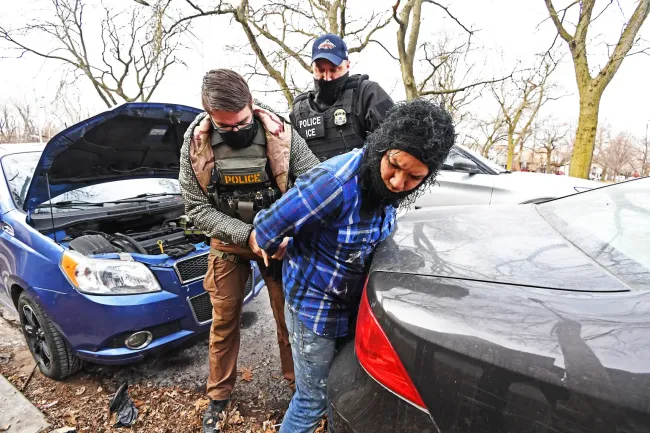Chicago’s Left-Wing Leaders Shield Criminal Illegal Migrants, Blocking ICE at Every Turn
In a city where left-wing politicians prioritize protecting criminal illegal migrants over public safety, ICE agents are fighting a losing battle. Despite tracking violent offenders with GPS monitors and federal backing, agents are met with locked doors, defiant silence, and a system rigged against them. Activist groups distribute "How to Escape ICE" flyers, while city officials ensure deportation orders go ignored. Even criminals with assault and weapons charges remain on the streets, shielded by Chicago’s radical sanctuary policies. As one ICE veteran put it, “It’s like the city is actively working against us—protecting criminals instead of its own citizens.”
On Thursday, after five exhausting hours in Chicago, 10 teams of about 10 ICE agents each managed to make just two arrests—an underwhelming outcome for an operation meant to crack down on illegal immigrants with criminal records. One of those taken into custody was Diego Antonio Montero, a 24-year-old Venezuelan national who illegally entered the U.S. in May 2023. ICE agents placed him in a caged van, yet Montero remained calm, asserting in Spanish that he was not a criminal and was confident a judge would set him free.
But the facts said otherwise. Montero had previously been arrested by Chicago police for criminal trespass, battery, and aggravated assault with a deadly weapon—charges still pending in Cook County’s Circuit Court. A warrant for his arrest had been issued on April 22, 2024, but in a city that prides itself on sanctuary policies, it was simply ignored.
For veteran ICE officer Sam Olson, with nearly 25 years in the field, this was nothing new. He acknowledged that tracking these repeat offenders was an uphill battle. ICE knew their targets because they had already been arrested, booked, and fingerprinted, yet local authorities refused to notify them when these individuals were back on the streets.
Montero wasn’t just evading local law enforcement—he was also wanted by Homeland Security. After skipping a 2024 immigration hearing, a judge ordered his removal from the U.S. ICE had already arrested him once in August, detaining him until November 7 before releasing him into the Alternative to Detention Program with a GPS tracker. That same device led ICE agents right back to him, proving that the system designed to monitor these offenders was, in reality, keeping them free.
With the backing of the DOJ, FBI, and ATF—thanks to former President Trump and new Border Czar Tom Homan’s push for stricter enforcement—ICE teams hit the streets early for what they call "knock and talks." They were only allowed to begin knocking on doors at 6 a.m., another regulation shielding illegal immigrants from disruption. But in two attempts within the Humboldt neighborhood, the targets were prepared. They simply refused to open their doors.
At one house, three individuals watched from an upstairs window as ICE agents in bulletproof vests knocked repeatedly on the front and side doors. There was no panic, no fear—just indifference. After ten minutes, the agents gave up and moved on. Without federal warrants, which are rarely granted for these cases, ICE can only arrest someone if they voluntarily open the door.
Despite the media’s portrayal of ICE as ruthless enforcers, agents weren’t storming homes or rounding up families. Olson emphasized that they were targeting criminals, not innocent spouses or girlfriends. In one instance, ICE agents were seen calmly speaking with a woman, explaining why they were there. Meanwhile, organizations like Catholic Charities, La Voz Latina, and even school officials were running workshops and distributing flyers teaching illegal immigrants how to resist ICE enforcement. Informational videos advised them to assert their Fifth Amendment rights, refuse to speak, and never sign any documents.
Chicago’s stance on illegal immigration was crystal clear. In its official "Welcoming Letter," the city pledged to provide shelter, food, and medical care to all, regardless of immigration status, arguing that many new arrivals had endured treacherous journeys in pursuit of opportunity. Local law enforcement was explicitly barred from questioning, arresting, or prosecuting individuals based solely on their immigration status.
Homan didn’t mince words about what was happening. He accused Chicago of becoming a sanctuary for criminals, saying the city’s policies were essentially a "How to Escape ICE" handbook. But he made one thing clear—ICE wasn’t backing down. With new strategies in place and federal agencies lending their support, he was confident that arrests would increase.
The numbers are staggering. At least 11 million people are living in the U.S. illegally, with 77 percent having been here for over five years. Terry Newsome, a longtime activist and host of the Behind Enemy Lines podcast, expressed frustration that ICE agents were being forced into an uphill battle—not just against criminals but against politicians working to keep them in the country. He even claimed that Venezuelan criminal gangs like Tren de Aragua were being coached by Illinois Democrats on how to avoid deportation.
While President Trump has promised mass deportations, his efforts face fierce resistance from Hollywood and left-wing activists who continue to demonize ICE. Celebrities like Selena Gomez have painted agents as heartless operatives tearing families apart. But on the ground in Chicago, the reality was much different.
Olson, a seasoned professional with decades of experience, said ICE’s mission was simple: remove the worst offenders. He rejected claims that agents were targeting innocent people, emphasizing that they were upholding laws passed by Congress. Still, he admitted it was frustrating to see ICE officers portrayed as villains when they were risking their lives to keep communities safe.
